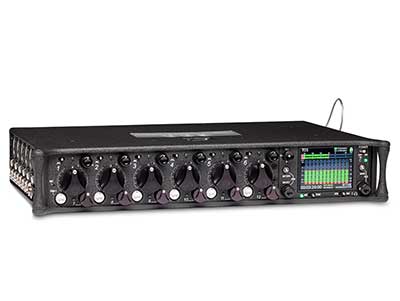
The Sound Devices 688 is a portable audio mixer/recorder that is a natural and logical next step in the product line. For owners of Sound Devices gear, the menu appearance and navigation about the unit is similar to the 664. It features 12 total inputs, including six mic/line (XLR) with phantom power, a highpass filter, input limiter and pan and six line-level inputs on TA3 connectors. The total of 12 analog inputs is plenty to handle most of the workload I experience here in Nashville, and adding the mini-fader option for tracks 7-12 makes it easier to use than the 664.
Routing is sophisticated and flexible, and the DSP-based MixAssist function supports up to 12 channels. All common sample rates are supported (192 kHz on six tracks) with monophonic or polyphonic BWAV files recorded to SD or CompactFlash cards. Other features include solid switches, faders, recessed controls and other inputs and outputs that will be familiar to all users of Sound Devices products.
For this review I had the optional SL-6, which adds several important features and takes the 688 up a notch from being just the next new mixer from Sound Devices. The unit uses Super Slot technology, a modification of UniSlot—the pin slot arrangement location mixers see mounted on camera backs, also known as camera hops. Sound Devices collaborated with several wireless manufacturers to enable the SL-6 to be used with a variety of receivers, provided they are wired for Super Slot. Companies having products onboard with the SL-6 include Lectrosonics, Sennheiser, Audio Ltd., and Wisycom.
Wireless Control
While my Lectrosonics 411s and SRB receivers would hardwire in just fine to the 688, I needed compatible receivers to use the SL-6. After reaching out to Lectrosonics, three Super Slot receivers arrived shortly after. A download of the manuals and a few YouTube videos later, the “build-out” began. I attached the SL-6 to the 688 using a few easily identified screws. The units “talk” to each other through a short ribbon cable attached via matching rubber ports, one on each unit.
I installed the Super Slot receivers into the SL-6 easily. I made sure the SRB receivers were properly sealed with supplied gaskets into the SL-6. I did not want any moisture or dust getting into the SuperSlot. When assembled, the SL-6 powers both the 688 and the SL-6. After I had reached this step, my kit was fully functional with six receivers and, except for headphones, not a cable in the bag—no BDS, no XLR jumpers, nothing. It is pretty cool when you see it for the first time.
The weight comparison between 688/SL and my current kit comprising three 411s with a Sound Devices 664 were within a pound. So for virtually the same weight, I doubled the number of receivers carried. One NP-1 battery inserted into SL-6 port powers both units. There is also a DC input on the other side of the SL-6; as a backup power source, I attached an NP-1 battery cup. This DC input will also power both units. Also, there are four DC battery outs and a built in BDS if you need to add more receivers. A USB charging port will make you look like a star when you charge the director’s phone from your kit. Concerning power consumption, the 688/SL-6 is on target for what it is driving. Granted, batteries ran down slightly faster, but not anything dramatic.
The capabilities of the 688/SL-6 fit my project style very well. I used the unit with several different cameras and timecode requirements. I can report that either generating or receiving timecode, the 688 performed very well. (This has been my experience with the 664, as well). There are certain features of the unit that, once set, I just don’t regularly use (such as comms and returns), simply because the features are not needed on the types of jobs I do. Recording, camera hops, wireless monitoring, transcription recording—all the workhorse functions necessary for my projects are without incident.
MixAssist and Routing
One of the new features on the 688 is MixAssist. It automatically attenuates the level of inputs that are not open and helps maintain consistent background sound levels regardless of the number of open microphones. This is a handy feature with multiple talkers (think reality or a panel discussion), or an overall loud sound environment with multiple mics (think concert venue or factory). MixAssist is Post fade only to L/R buses, meaning your Record tracks remain unaffected if needed by the post-production team. I found MixAssist particularly useful on two jobs.
Here in Nashville, crews are frequently in backstage areas getting interviews while there is a performance going on somewhere nearby. For this job, the crew was backstage in a large dressing room interviewing three songwriters about the hit they wrote while a performance was going on in the 500-seat venue. MixAssist kept the musical “din” to a manageable level, and whenever one of the three spoke, their mic cut through cleanly.
The SL-6 has two dynamic features. One is the ability to route receivers to inputs quickly. This is especially helpful when adding additional analog receivers. Located in the Input Setting screen, an easy-to-navigate grid menu lets you move the SuperSlot receivers to Channels 7-12, opening up analog inputs 1-6 for the additional receivers. Naturally, you have to add cables at this point. (And the built-in BDS—the DC Outs—work well.) And, if you find yourself in an under-the-gun situation where you have to add or route things differently, to be able to move things around with minimum cable handling time can be a life saver.
Antennas and Transmitters
Besides being a BDS and XLR cable-free bag, the antenna distribution keeps the antenna garden to the minimum. Without the SL-6 and SuperSlot receivers, the mixer bag would have six antennas sticking out for three Lectrosonics dual-channel receivers. SL-6 antenna count: two antennas for six receivers. This is much cleaner, and the reception is better as the antenna are more separated than operated side by side in the bag.
Lectrosonics was kind enough to send along two new LT Transmitters to round out the Super Slot receivers. Paired up with the four other types of Lectrosonics transmitters I carry, I was using five different types of Lectro transmitters. I’m happy to report that they all worked fine with the SuperSlot receivers, and played well among themselves, too. I particularly like the new LT Transmitters. It seems easier to move around the menu than models past. And I like the fact they are multi-block transmitters—truly much more flexible than single-block transmitters of the past.
Wonderful Workflow
One thing about the 688/SL-6: There is not one feature in the kit that a client will pay for. It’s not like you’ve added a specialty mic to the inventory. Most clients care that it is recorded with quality and that everything syncs. They don’t care that MixAssist made your recording easier. It doesn’t register that you can move frequencies or route to different inputs much easier and quicker than before. But it matters to the mixer when those few minutes of extreme pressure occur when RF issues come up, or when EQ needs to be added to the existing bag or the countless other things that occur in our world.
The unseen feature that the unit gives the mixer is confidence. Knowing that you can make changes rapidly, carefully monitor the system and have options makes a difference when it gets hairy. The other feature mixers may discover: time—less time in the white-knuckle zone for sure. And no wires and six receivers in line means you spend far less time getting ready for your next gig.
Perhaps the biggest drawback I see is the cost factor in making the changeover to SuperSlot receivers. Some manufacturers will modify existing units to SuperSlot, but this still may be cost-prohibitive to some. I think pairing the SuperSlot receiver with multi-block transmitters would be the most flexible in both cost and operation. Like many mixers, I have made a financial commitment with analog gear that works perfectly fine for virtually everything I run across. However, the flexibility of SuperSlot is very enticing, especially if you are considering an equipment upgrade or a new purchase.
Production veteran Ron DiCianni’s work includes projects with recording artists, news stories, Internet and entertainment programming.
Product Summary
COMPANY: Sound Devices
PRODUCT: 688 Mixer/Recorder; SL-6 Powering and Wireless System
WEBSITE: sounddevices.com
PRICE: $5,749 688 Mixer/Recorder; $1,495 SL-6 Powering and Wireless System
PROS: SL-6 integration enhances workflow and quickens set up.
MixAssist is a valuable feature.
CONS: SL-6 upgrade requires purchasing costly SuperSlot-compatible receivers.







